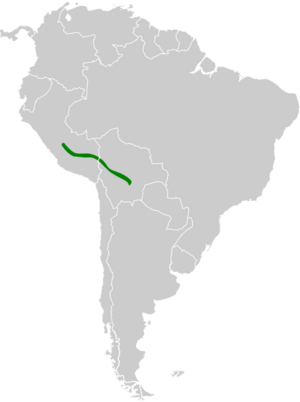Blue-banded toucanet facts for kids
Quick facts for kids Blue-banded toucanet |
|
|---|---|
 |
|
| Conservation status | |
| Scientific classification | |
| Genus: |
Aulacorhynchus
|
| Species: |
coeruleicinctis
|
 |
|
| Synonyms | |
|
|
The blue-banded toucanet (Aulacorhynchus coeruleicinctis) is a colorful bird from the toucan family. It lives in the high mountains of Bolivia and Peru. This bird is known for its unique blue band across its chest.
Contents
What Does the Blue-banded Toucanet Look Like?
The blue-banded toucanet is about 40 to 44 centimeters (16 to 17 inches) long. It weighs between 173 and 257 grams (about 6 to 9 ounces). Both male and female toucanets look very similar.
- Beak: They have a bluish, horn-colored beak.
- Body: Their feathers are mostly green.
- Special Marks: They have a red patch near their tail. A soft blue band crosses their chest, and their throat is white.
- Eyes: They have blue and white "eyebrows" above their eyes. There is also some pale blue below their eyes. Their eyes can be white, yellow, or reddish-brown. Dark gray skin surrounds their eyes.
- Tail: Their tail is mostly green with rusty tips on the central feathers.
Young toucanets look a bit duller than the adults.
Where Do Blue-banded Toucanets Live?
These toucanets mostly live on the eastern side of the Andes mountains. You can find them from central Peru down to the Santa Cruz Department in Bolivia. They also live in a few other isolated spots further east.
They prefer to live in moist, subtropical mountain forests. These are often called cloudforests because they are frequently covered in clouds. Blue-banded toucanets are usually found at elevations from 1,600 to 2,500 meters (about 5,200 to 8,200 feet) above sea level.
How Do Blue-banded Toucanets Behave?
What Do They Eat?
Blue-banded toucanets search for food at all levels of the forest. They might forage alone, in pairs, or in small groups. Their main diet is fruit. They also eat insects and other small creatures like spiders.
When Do They Nest?
Not much is known about their nesting habits. In Peru, they seem to nest from January to April or even later. In Bolivia, their nesting season appears to be from August to January.
What Sounds Do They Make?
The song of the blue-banded toucanet is a series of barking, growling notes. It sounds like "kunnk" to "krakk." They also make various rattling calls, "kyak" yelps, and compound notes like "kra-a-a" and "gek-ek-ek."
Are Blue-banded Toucanets in Danger?
The IUCN (International Union for Conservation of Nature) has listed the blue-banded toucanet as a species of "Least Concern." This means they are not currently considered to be in immediate danger of extinction.
Even though they have a large natural range, their exact population size is not known. Scientists believe their numbers might be slowly decreasing. There are no major threats identified right now. In Peru, they are considered "generally uncommon." More studies are needed to learn about their breeding and how they live in their environment.
Images for kids



